
Project 1134A (Berkut A)
 10 cruisers: Kronstadt, Admiral Isakov, Admiral Nakhimov, Admiral Makarov, Admiral Voroshilov, Admiral Oktyabryskiy, Admiral Isashenko, Admiral Timoshenko, Vasily Chapayev, Admiral Yumashev
10 cruisers: Kronstadt, Admiral Isakov, Admiral Nakhimov, Admiral Makarov, Admiral Voroshilov, Admiral Oktyabryskiy, Admiral Isashenko, Admiral Timoshenko, Vasily Chapayev, Admiral Yumashev
The Kresta II class missile cruisers (Project 1134A, or Berkut A) were like the Kresta I anti-ship cruisers re-evaluated as ASW cruisers when the design was still ongoing. Their armament, to differentiate themselves from the first Kresta I, consisted in 8 new SSN-9 short-range anti-ship missiles. But what was originally planned was not realized due to lack of technical maturity, and they were replaced by 8 SSN-14 “Flint” ASW systems (with optional tactical nuclear warhead of 10 Kt), with many other alterations. They were all built by the Zhdanov Shipyard in Leningrad and distributed in the Baltic (2), Arctic (5), and Pacific (3). In 1990, all ten were active: They were removed from service in 1991, 1992, and 1993.
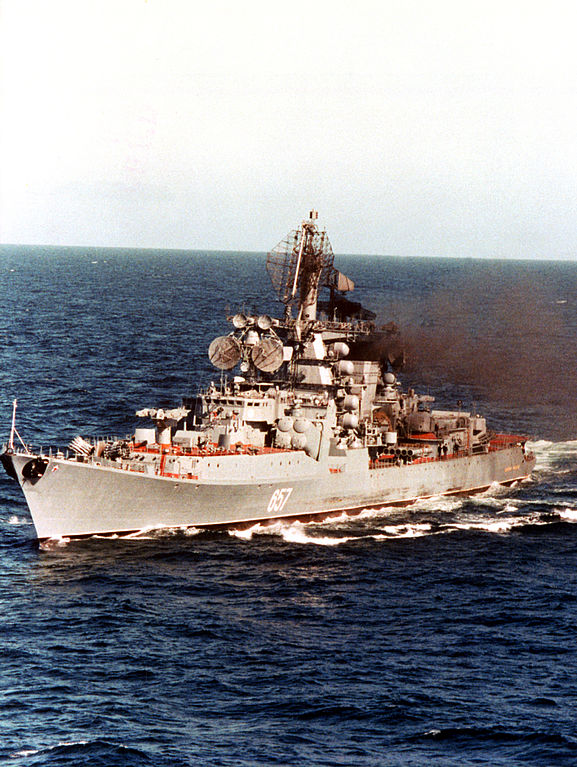
A Kresta II class cruiser, Admiral Yumashev, in January 1982.
Design development
Context: ASW first
In the 1960s Soviet domestic shipbuilding there was a shift in priorities for subjective reasons. At that time, the construction of surface ships was carried out in two general directions: “anti-ship” and “anti-submarine”. The deployment of the Polaris A1 system in the United States naturally, raised the need to strike potential enemy’s SSBNs. In this regard, even political and state leaders far from naval affairs, knew the “anti-submarine” had a positive understanding which almost at every turn guaranteed the “green light” to any program.
By 1964, a program was implemented to build missile cruisers, called Project 58 Grozny (Kynda class), which, for their indisputable merits, had many drawbacks. Way too cramped by their displacement and dimensions, requirements for improving the crew’s living conditions as well as improving “combat service” became impotant. As well as reinforcing Air defense, and increasing their operational range. In the end, advances in missile made complex and cumbersome rotary launchers obsolete. Practice shown this reloading was rather laborious and protracted, unsuitable in real combat conditions. The temporary helicopter spot also was unusable in heavy seas and the helicopter was soon compromised by seawater corrosion.
Start of Proyekt 1134
Based on these observations, the formal basis for the development of a new project numbered 1134 (later awarded the code “Berkut”, for “golden eagle”) was adopted by the Central Committee and Council of Ministers under the No. 1180-510 decree on 12/30/1961. Shortly before its release however, the Main Shipbuilding Directorate ordered the Northern Ship design bureau the development of a new air defense cruisers immediately from the technical design stage, bypassing the conceptual phase entirely. Chief designer of proyekt 1134 was V.F. Anikiev, later chief designer of the future Kuznetsov. Navy staff Observation were translated in the design by Captains A.A. Maiorov, and O.T. Safronov.
When designing the new Pr.1134 Berkut, the aforementioned requirements were largely taken into account, as the newly designed, enlarged hull had boiler and turbines essentially similar to the Kynda class, while a second Volna air defense system was fitted with the anti-aircraft missiles increased two folds with the introduction of conveyor storage. Composition of the electronic suite was changed accordingly, and instead of a second Angara radar, a new Kliver radar and a Gurzuf active jamming station were installed.
Also a permanent aft hangar for the Kamov Ka-25RT helicopter was fitted, ensuring they would be well protected from the elements. The looser of this rearrangement was the ship’s (anti-ship) strike capabilities: Four P-6 in paired launchers with no proper guidance and without reload was installed on the inital design. The Shtorm air defense missile system which was planned was never ready in time so the Pr.1134 Berkut was given the older Volna air defense system (SA-N-1). Instead of the 76-mm AK-726 gun mounts, faster-firing new AK-725 twin AA guns with individual control (Bars radar) were installed.
From the very beginning, Proyekt 1134 Berkut received an external target designation system for the P-6 missile. To control the ship and establish datalink, it was assisted by a combined GKP-FKP-BIP system exhanging mutual information and other necessary equipment. It was complex but very advanced at that time;
The new Pr. 1134-A (Kresta II) were classified as “large anti-submarine” cruisers. In this regard, composition of their ASW suite was somewhat strengthened. Instead of triple torpedo tubes, quintuple models PTA-53-1134 with anti-submarine torpedoes “Raccoon-2” were installed. Two more RBU-1000 medium-range RLs were installed, but firing rockets with larger warheads. In addition, RBU-6000 rocket provision was increased and during a design revision it was decided to abandon spare anti-ship missiles, further specializing the ships for anti-submarine warfare. Eletronically, the Titan all-round radar and Vychegda target designator were installed as well as a more specialized anti-submarine helicopter which could carry five PLAT-1 torpedoes and 54 RGAB depht-charges (with optional nuclear warhead).
Despite all of these alterations, the first four Pr.1134 Berkut turned out to be a “step in place”, and although at the end of the 1970s they were retrained as missile cruisers, they could not be considered as such by their limited capabilities and initially their fire control system only guided two anti-ship missiles simultaneously. Their anti-submarine capabilities were limited, due to the old, weak sonar and limited anti-submarine suite. Nevertheless, the “Berkut” class became the founders of the largest family of large anti-submarine ships of Soviet Navy with 14 vessels, before the Kara class.
Design of the Kresta II class
Hull and general arrangements
Having the same dimensions, the Kresta I and II were also very close in displacement: 5,600 tons standard and 7,535 tons fully loaded and about the same for the Kresta I. The machinery was the same, as well as the internal cmpartimentation and double hull. The ship had no armour. Machinery, speed, and range were about the same.
What made these cruisers different was their main missile armament (with larger quad launchers) and new radar systems. The best recoignition tip was their large “Top Sail” air search radar used for the new SA-N-3 long-range launchers. The bow rake was also different was as the sonar and other systems.
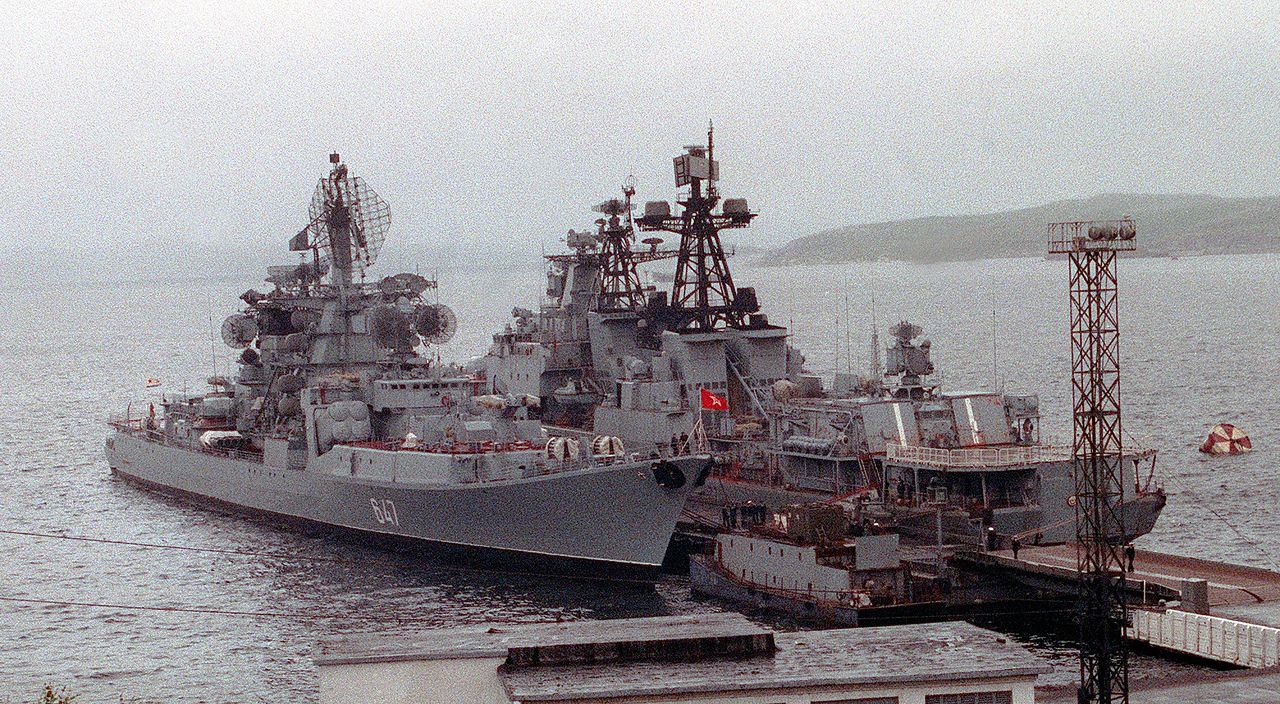
Powerplant
The machinery space received two TV-12 sets of steam turbines, with high-pressure boilers. Basically this was the same powerplant as for the Kresta I class. The steam turbine were fed by four watertube boilers, for a total output of 91,000 up to 100,000 horsepower with forced heat. This was enough to procure these ships a top speed of 33 knots (61.1 km/h, 39 mph) up to 34 knots on trials. Their operational range was up to 10,500 nmi (19,400 km; 12,100 mi) at 14 knots (26 km/h; 16 mph), down to 5,200 nmi (9,600 km; 6,000 mi) at 18 knots (33 km/h; 21 mph). They carried in peactime 1,830 tons of fuel oil.
Armament
Alongside their antiship missiles, the other innovation was their new surface-to-air missiles (SA-N-3), and advanced sonar. For Conway’s only the first three ships of the class were to be fitted with SS-N-9s, however a change in naval doctrine placed a greater emphasis on anti-submarine warfare.
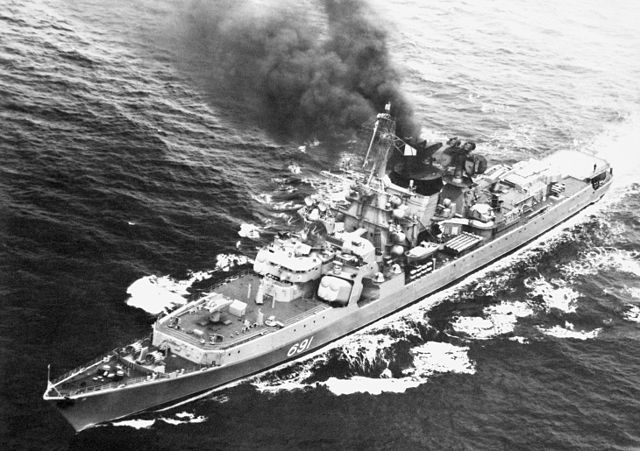
Marshal Timoshenko in 1986
Anti-submarine missiles
The main weapon system was not anti-ship but anti-submarine: Two quadruple launchers, installed on either side of the main bridge, framed by the open bridge legs. In total, eight SS-N-14 Silex, known in the Soviet Navy as the Metel Antiship complex. Conrary to the common RBU rocket launcher systems, the Metel was far more precise and had a mych greater range.
Weight: 3,930 kg (8,660 lb), length 7.2 m (24 ft) overall.
Warhead: ASW torpedoes/nuclear depth charge. Late versions: Multi purpose torpedoes/185 kg shaped charge warhead in antiship role.
Propellant: solid fuel rocket, range 5 – 50 km in anti-submarine role. They could reach a depht of 500 metres. When flying, top speed was Mach 0.95, 290 m/s (650 mph), and they used a Radio command guidance, via helicopter and an IR seeker for the final approach.
In addition to the Kresta II, this weapon system was also used on the Kara, Burevestnik 1 & 2, Udaloy I and Kirov classes. It proved a dependable weapon until the end of the cold war.
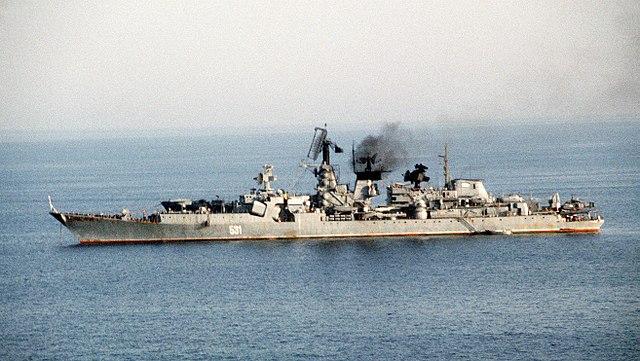
Admiral Oktyabrsky Hormuz 1990
Long Range Anti-Air Missiles
The SA-N-3 “Goblet” missile launchers were two twin mounts, fore and aft, like for the Kresta I. They were assisted by a new 3D search radar and new fire control radars. The SA-N-3 was much improved compared to the previous SA-N-1 “Goa”: Known in the Russian navy as M-11 Shtorm, it was tested on the pair of Moskva class helicopter cruisers, but officially accepted into service until 1969.
Carried in pairs, on rotating twin rail launchers they flew to their targets between Mach 2 and Mach 3. 6.1 m (20 ft) in lenght, and weighting 845 kg (1,863 lb) they carried a 80 kg (180 lb) warhead. Effective altitude was up to 25,000 m (82,020 ft) allowing them to shot down strategic bombers. Engagement range could be as low as 3 km, up to 30 km (1.9–18.6 mi) and up to 55 km (34 mi) for the late version. It was guided is via radio command, with the “Head Lights” radar, working in conjunction with a large “Top Sail” search radar. The Kresta II carried 72 of these.
Short Range ASW:
The Kresta II relied on the combination of two weapons systems: Rocket launchers, of two types, and torpedo tubes.
-Two RBU-6000 12-barrel anti-submarine rocket launchers, mounted at the prow, with 144 in reserve.
-Two RBU-1000 6-barrel anti-submarine rocket launchers, mounted on either side of the hangar aft, with 60 in reserve.
-Two quintuple torpedo tubes banks, of the standard 533 mm (21 in) antiship/ASW model.
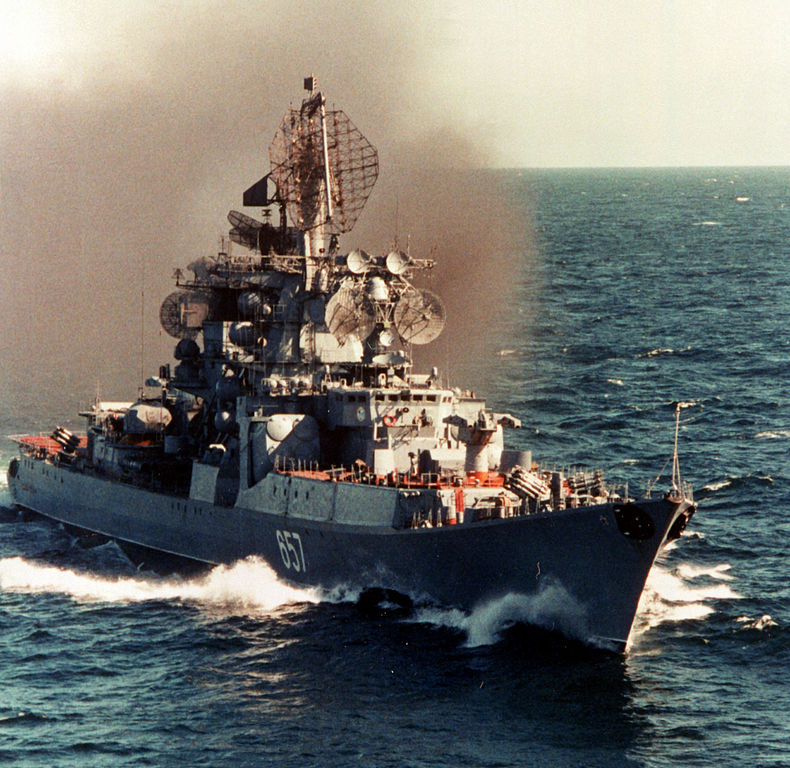
Admiral Yumashev, 1982
Close AA/AAM defense
AA Guns: The Kresta II had two twin 57-mm/70-cal AK-725 anti-aircraft guns mounted on either side of the aft radar tower on the superstructure bridge.
CIWS: The ships received four 30mm AK-630 CIWS guns mainly for anti-missile defence. They were placed on two raised platforms on either side of the superstructure, in between the bridge and main radar mast, located just behind the fire deflector of the Silex missile launchers.

Admiral Yumashev in 1985
On Board aviation
The presence of a permanent helicopter since the Kresta I as acquired, with a single hangar and spot aft. This was a Ka-25 Hormone B used for missile data link, ASW patrol and strike and SAR (Search & Rescue).
Electronics
Radars: One Don Kay, a Don-2, a Top Sail (main tower), Head Net. The MR600 air search radar MR-310 Angara was coupled with a Don and Volga navigational radars.
FCS radars: Two Grom SA-N-1 fire control “Head Lights”, two MR103 AK725 “Muff Cob”, and two Drakon RP33 “Bass Tilt”.
Sonar: MG-322 NATO ‘Bull Nose’, a more advanced sonar than the MG-312/MG-26, also leading to a redesign of the bow, which was more sharply raked. Later were added 8 CME Side Globes to guide the missiles, seven Bell Series FCS.
They had also the MG-26 communications outfit and a MG-35 Shtil system. Th first four had to manually target the AK-630 CIWS, but the rest of the class called for the MR-123 Vympel fire control radar.
Replenishment oiler Berezina and aircraft carrier Kiev and Kresta in escort, 1985

Kresta II author’s illustration
Proyekt 1134A Berkut Specifications as completed |
|
|---|---|
| Dimensions | 159 x 16.8 x 5.32m (522 ft x 56 ft x 20 ft) |
| Displacement | 5600t, 6556t FL Fully Loaded |
| Propulsion | 2 shafts DGC turbines, 4 boilers, 91,000 hp, 32 knots. |
| Range | 1830t fuel, 10,500 nmi/14 kn, 5,200 nmi/18 kn |
| Armament: Missiles | 2×4 SS-N-14, 2×2 LM SA-N-3 |
| Armament: Rockets | 2 RBU 6000, 2 RBU 1000 |
| Armament: Guns & others | 2×4 SS-N-14, 2×2 LM SA-N-3, 2×2 x 57mm, 2×5 TT 533mm |
| Onboard aviation | Kamov Ka-25 ASW helicopter |
| Electronics: Radars | Don Kay, Don-2, Head-Net C, Top Sail |
| Electronics: FCS | 2 Head Lights, 2 Peel Group, 2 Muff Cob, 2 Bass Tilt |
| Electronics: Sonars & Jamming | Sonar Bull Nose, 8 CME Side Globes, 7 Bell Series. |
| Crew | 340 |
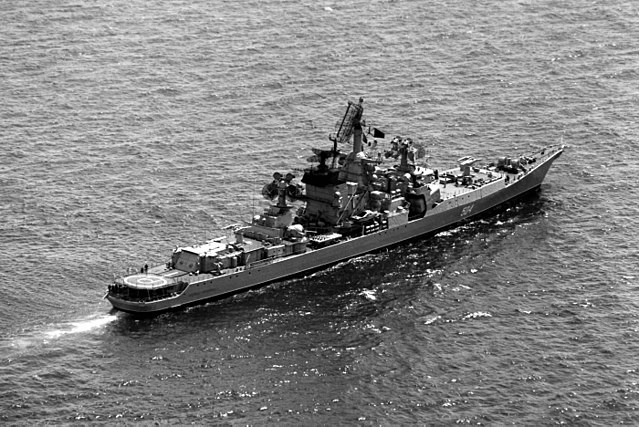
Marshal Voroshilov 1990
Src/Read More
https://en.wikipedia.org/wiki/Kresta_II-class_cruiser
http://www.ww2.dk/new/navy/kresta-2.htm
https://www.awm.gov.au/collection/C195372
http://russianships.info/eng/warships/project_1134a.htm
https://www.globalsecurity.org/military/world/russia/1134.htm
https://www.iwm.org.uk/collections/item/object/205302960
http://www.institut-strategie.fr/SSP_5.htm
https://www.navypedia.org/ships/russia/ru_cr_kronshtadt.htm
http://ship.bsu.by/ship/100600
https://kresta-ii.ucoz.ru/
Model Kit: Missile Cruiser Admiral Zozulya Project
1/1250 model
1/700 model on shapeways
Averin, A.B. (2007). Admirals and Marshals: Ships Project 1134 and 1134A, Moscow: Voennaya Kniga.
Gardiner, Robert (ed.) (1995). Conway’s All the World’s Fighting Ships 1947–1995.
Gardiner, Robert; Chumbley, Stephen; Budzbon, Przemysław (1995) Same. Annapolis, MD: Naval Institute Press.
Hampshire, Edward (2017). Soviet Cold War Guided Missile Cruisers. New Vanguard 242. Osprey Publishing.

Vasiliy Chapaev and Nikolai Vilkov in 1990, Vladivostok
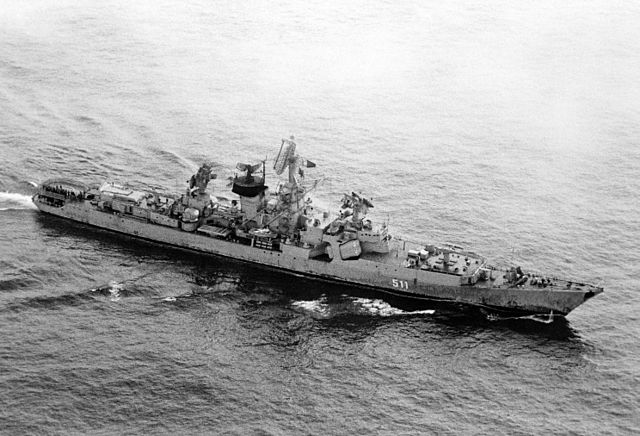
Vasiliy Chapaev in 1983
The Kresta II class in service
Kronshtadt
Built under serial no. 721 on 30.11.66, launched on 10.2.68 she was completed 29.12.69. From September 1970 she was attached to the 120th Missile Ship Brigade, Northern Fleet). She was sent to Sevastopol for testing the missile systems Metel and Shtorm-M in the summer, and from 15 may next year to 22 july she was back to Severomorsk after taking part in operations in the Mediterranean. In September-October she shadowed NATO, observing and tracking the exercise “Iron Knight”. In February-March 1972 she took part in a rescue operations, to try to find survivors from K-19 in the North Atlantic. In May 1973 she took part in the exercise “Laguna”, in search of NATO submarines in the Northern Atlantic. Admiral Nakhimov sailed with her. From 22 June, she conducted her first SS-N-14 launch in the Northern Fleet area.
In September-October 1974 she took part in Northern Atlantic manoevers with the fleet. In April 1975 she took part in the “Okean-75” exercise. On 16 june, she collided with the missile cruiser Smyshlennyy and was damaged, so she sailed to Kronstadt, her namesake port, arriving on 19 July 1975 to undergo repairs until January 1980 as well as a modernization later at KMOLZ in Kronstadt, took over by the 95th Battalion of Construction and Overhauls. She was fitted with the new fire control system “Vympel-A”. In May 1980 she was back to Severomorsk in the northern fleet, arriving on 21 may to join her old unit, the 120th Missile Ship Brigade. In July 1981 she took part in the “Sever-81” exercise, in the Barents Sea and also cruiser Norwegian waters with the Kirov, Admiral Isakov and the destroyer Smyshlennyy.
On 12 February 1982, she was transferred to the 170th Anti-Submarine Warfare Brigade. She took part in rescue operations after the “K-123” submarine was reported missing. Kiev and Marshal Timoshenko took part, and she escorted the rescue vessel Altay but return early on due to machinery problems. In April-May 1982 her powerplant was completely revised at SRZ-35, Rosta. On 30 December that year her fire control system “Grom-M” was accidentally damaged. It will happen again in March 1984 and she was repaired at SRZ-35, in Rosta. September-October 1984 saw her in operations along the Faroe-Iceland, famous GIUK gap submarine barrier. In November 1985 she underwent a new overhaul, lating until June 1986 at SRZ-35 Rosta. In March 1987 she took part in a command staff exercise with the Kirov and Vitse-Admiral Drozd, Marshal Ustinov, Admiral Nakhimov, Admiral Makarov, Admiral Yumashev, and the destroyers Soobrazitelnyy, Otlichnyy, Otchayannyy and the Sovremennyy. The exercize of fleet cooridnation was a success, and it was her last large deploymenent. Soon the USSR collapse started and on 24 june 1991, after a long mothballing period in 1987-1991 she was ultimately decomissioned. In 1993 as funds were lacking for a modernization, she was sold to an Indian shipbreaker.
Admiral Isakov
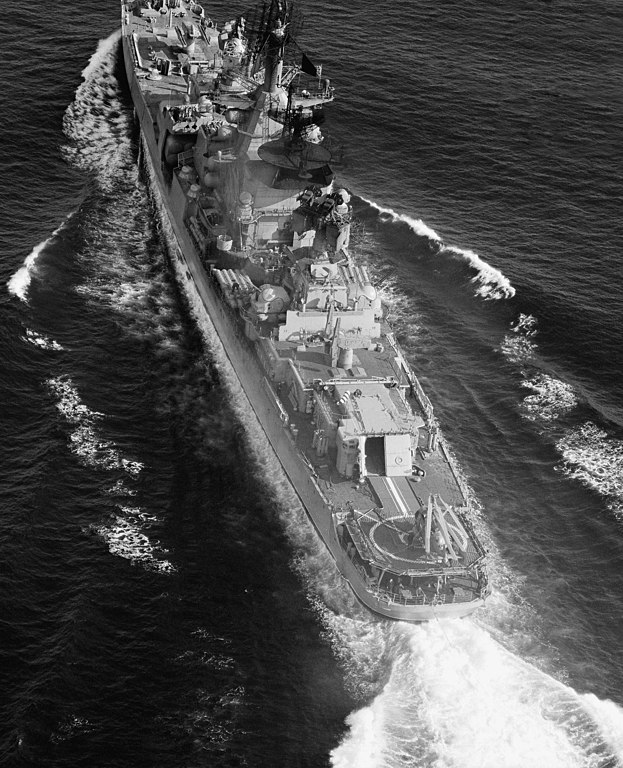
Admiral Isachenkov underway aerial port quarter view, 1985
Built under the serial no. 722 from 15.1.68 to 22.11.68 and completed 28.12.70 the new cruiser underwent tests in Sept.-Oct. 1970 in the Baltic. In April 1971 she sailed from Kronshtadt to Severomorsk but suffered a boiler issue on 19.4.71. She was attached to the 120th Missile Ship Brigade and took part in the fall to tracking operations againt the US Navy in the Barents Sea and Norwegian Seas. Until June 1972 she trained in the Mediterranean, visiting Annaba (Algeria) and showing support to Egypt. She experienced another boiler failure in the Norwegian Sea on er way back. For most of 1973 she was in the Atlantic and took part in the exercise “Laguna”. In August, visited Havana (Cuba) and in April 1974, took part in the exercise “Okean-75”. In 1975 she alternated between the Central Atlantic and Mediterranean. In 1976 she was attached as an escort to the Kiev during her main missile systems tests off Kolguyev Island. In 1977 she took part in the “Sever-77” exercise.
From June 1977 to April 1980 she underwent a long overhault and modernization in Rosta, receiving the new FCS “Vympel-A” and retunred in operations in May in the Barents and Norwegian seas. She collided with HMS Glasgow ubut without much gravity and participated in the summer in the “Sever-81” exercise with Kirov and Kronshtadt. In 1982 she was attached to the 170th Anti-Submarine Warfare Brigade and trained in the Central Atlantic and Mediterranean with Kiev/ She made two training exercises in the Greeland Sea, “Natyag” and “Atoll” and later “Shschit-82” and was repaired in November 1982 at SRZ-13, Sevastopol. By December she was back in Cuba, visiting Havana and Cienfuegos.
By early 1983, she was in the Northern Atlantic and arrived at Severomorsk to escort Novorossiysk on her way to the Pacific, from Severomorsk and off Gibraltar. In 1984 she took part in the “Atlantika-84” exercise and from late 1986 to 1990 was sent foa major overhaul and modernization at SRZ-35 in Rosta, receiving the Rastrub-B (SS-N-14B) missile system and satcom R-790 “Tsunami-BM” and ADK-3M Sluz automated launch system. In 1991 she was attached to the 44th Anti-Submarine Warfare Division until June 1993, whe she was decommissioned, sold the next year to India.
Admiral Nakhimov

Admiral Nakhimov 1979
Laid down on 15.1.68, launched 15.4.69 and completed 29.11.71 Nakhimov was attached from 13.12.71 to the 170th Anti-Submarine Warfare Brigade in Severomorsk. In 1973 she was in operations in the Central Atlantic and Mediterranean and took part in the exercises “Ladoga” and “Duet”. In the Med, she was anchored in the Bay of Sallum, Egypt, to show support to the regime. However one sailor defected and she was ordered back to Severomorsk: Both the captain and political officer were demoted and reassigned. She was visited by the Soviet Navy Commander admiral Gorshkov and in 1973 took part in the exercise “Laguna”.
In March 1974 she was visited by Marshal Moskalenko and until the fall of that year was in operations in the Mediterranean and Central Atlantic. In July she evacuated Soviet citizens from Limasol in Cyprus during the Turkish invasion. She visited Havana in September and took part in 1975 in the exercise “Okean-75” with Admiral Makarov. Until the end of the year, she alternated between the Mediterranean and Central Atlantic, notably tracking the USS Nimitz. In 1976-77 the routine repeated without notable event. She took part in the “Sever-77” and “Estafeta-77” air defence exercises and visited Conakry (Guinea) and Luanda (Angola). Until late 1979-1980, same routine, and from February 1981 to May 1982 she underwent her major overhaul and modernization at KMOLZ, Kronshtadt (95th Battalion), receiving the “Vympel-A” and ADK-3M ALS.
She returned to Severomorsk and return to her routine of exercises in 1983 in the Central and Southern Atlantic, but was based at Luanda for a time, as flagship of the 30th Operational Brigade and then Conakry for two weeks. She took part in the “Atlantika-84” exercise and escorted Frunze to the Pacific from Severomorsk. On 14 Feb. 1986 she collided with K-255 and was repaired at SRZ-35 Rosta. In 1987 took part in a very large command staff exercise. In 1989 she was sent to SRZ-35 Rosta for another overhault and modernization, never completed. Mothballed in 1991 she was decomissioned and sold for BU in 1993.
Admiral Makarov
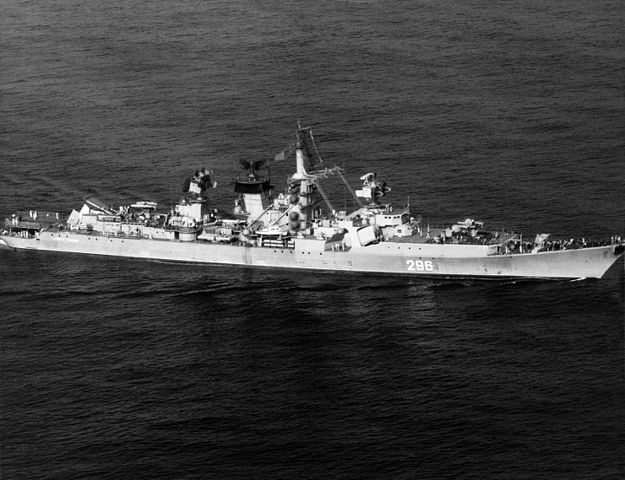
Admiral Makarov 1985
Laid down on 23.2.69, launched 22.1.70 and completed 25.10.72, Makarov started her sea trials and training in the Baltic in 1972 and in 1973 she was attached to the 170th Anti-Submarine Warfare Brigade. She sailed from Kronshtadt to Baltiysk, visited by the Soviet Minister of Defence Grechko and commander of the Soviet Navy Gorshkov. She left for Severomorsk but collided in heavy fog with the Czechoslovakian “Sladno” in the Fehmarn Belt, returning to Baltiysk for repairs at KMOLZ, Kronshtadt. Back to Severomorsk she took part in the exercise “Laguna” and in 1974 received another visit from Gorshkov. In 1975 she was in operations in the Central and Southern Atlantic and visited Havana and Cienfuegos, later Casablanca and took part in the “Okean-75” exercise.
The routine resumed in 1976 and she was based for some time in Luanda (Angola) to ensure safe passage of Cuban transports duing the war. She also visited Conakry and in 1977 was attached to the 120th Missile Ship Brigade. In 1978 she trained in the Norwegian and Barents Seas, tracking NATO “Northern Wedding-78”. In 1979 she took part in a large command staff anti-submarine warfare exercise “Rasbeg-79”. In 1982 she was attached to the 170th Anti-Submarine Warfare Brigade and in 1983-1985 received her major overhault (same as the others). In 1986 she was back in the Mediterranean, test-firing her SS-N-14 missiles and in 1987 took part in another command staff exercise. Until 1988 she operated in the Mediterraneanand was based in Tartus, Syria. On 20.2.88 there was a fire onboard, but limited damage. She also visited Latakia (Syria) and tracked USS Dwight D. Eisenhower. From October 1991 she attached to the 44th Anti-Submarine Warfare Division but decomissioned in 1994 and sold for BU.
Marshal Voroshilov
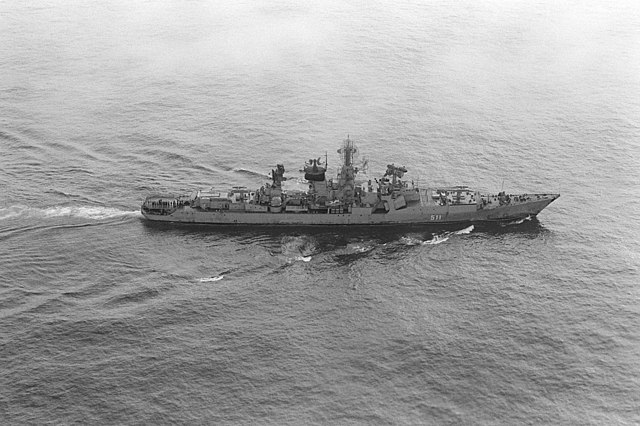
Soviet cruiser, Marshal Voroshilov 1983 Central Pacific
Voroshilov was laid down on 20 March 1970, launched on 8 October and completed in September 1973. She sailed from Kronshtadt to Vladivostok for basic training and made her shakedown cruise in the Indian Ocean until 1974, and the east african coast, visiting Port Louis (Mauritius) Malabo (Mozambique), Berbera (Somalia) and in June was attached to the 201st Anti-Submarine Warfare Brigade. In 1975 she returned in the Indian Ocean. Same in 1976 and until the end of 1977 she underwent an overhault at Dalzavod in Vladivostok. She was hit by a storm in the Sea of Japan, and suffered some damage. In Aprol 1978 she took part in a large exercise observed by General Secretary Brezhnev and Minister of Defence Ustinov onboard Admiral Senyavin.
From July 1979 to March 1980 she was in operations in the Indian Ocean and Hormuz Strait and tracked USS Nimitz there. She also visited Victoria (Seychelles) and Massaua (Ethiopia), Maputo (Mozambique) and Colombo (Ceylon).
From November 1980 to March 1986 she underwent her major modernization at Dalzavod (Vladivostok) receiving the SS-N-14B, R-790 satcom, ADK-3M chaff launcher. In 1988 she took part in a lage ASW exercise in the Sea of Okhotsk with Tallin. Until May 1989 she was operations in the South China Sea and Indian Ocean, based at Cam Ranh Bay in Vietnam. On 20 December 1990 she collided with the frigorific ship Gorets in the eastern Bosphorus Strait, was renamed “Khabarovsk” in 1991 but in 1992 she was placed in reserve, decomissioned in Vladivostok, and almost destroyed by a fire, BU in place.
Admiral Oktyabrskiy
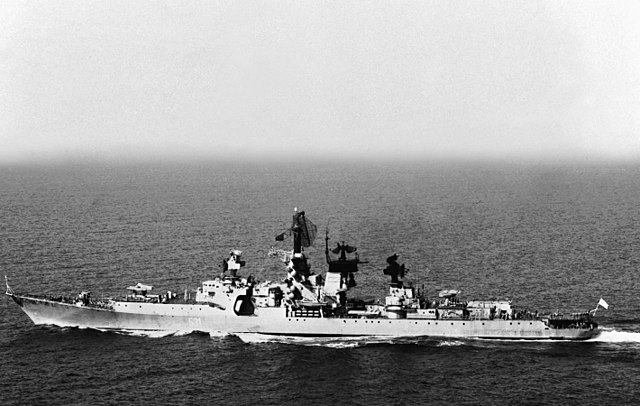
Cruiser Admiral Oktyabrsky 1990
Built in Zhdanov under serial no. 726 from 2.6.69 to 21.5.71 and completed in 28.12.73, Admiral Oktyabrsky started training in February 1974 and was attached to the 201st Anti-Submarine Warfare Brigade. She sailed to Vladivostok and started operations in the Indian Ocean. In East Africa, she visited Berbera (Somalia), Aden and Colombo (Sri Lanka) and underwent Suez canal operations off Cape Guardafui until 1975. She made her first fire trial of the SS-N-14 in the Pacific Fleet. Until May 1977 she took part in the ASW exercise “Piton” with Strogiy, Gordyy, Gnevnyy and Razyashchiy in the Philippine Sea. Back in the Indian Ocean for he second part of the year and trained with Chapaev and another exercise observed by General Secretary Brezhnev and Minister of Defence Ustinov onboard Admiral Senyavin.
Until late 1978 she was back in Indian Ocean, making the ASW exercize “Piton” with Chapaev and Razyashchiy in the Philippine Sea. Until late 1979 she underent her major overhaul at Dalzavod, Vladivostok and in 1980 she was operations in the Indian Ocean, stopping at Tamrida (Sokrota) and South Yemen. She trained with Admiral Fokin and Storozhevoy. She visited Dakhlak and Aden, and returned home for inactivation and a new overhault and modernization from December 1982 to October 1986 in Vladivostok. By mid-1988 she made a post-reconstruction trials, training and firing exercises and in august 1990 to Feb. 1991 she was back to the Indian Ocean and Persian Gulf. She was decomm. in 1993.
Admiral Isachenkov
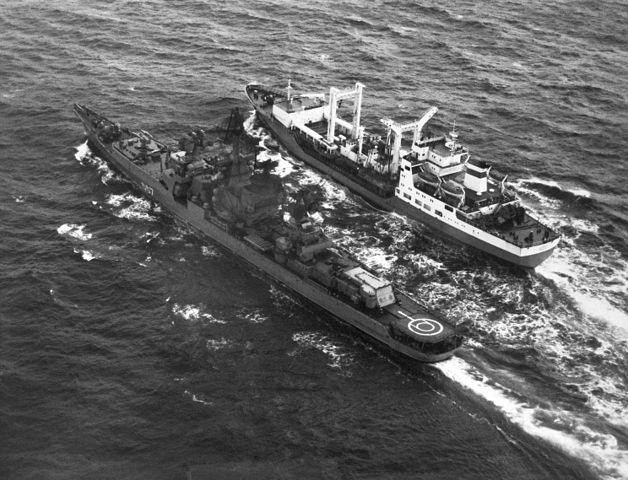
Admiral Isachenkov supplied by Dubna, 1985
She was laid down on 30.10.70, launched 28.2.72 and completed 5.11.74. From the 27 Sept. until November 1974 she trained in the Baltic and later sailed from Liepaya to Severomorsk. She was attached to the 170th Anti-Submarine Warfare Brigade. In March 1975 Admiral Isachenkov was visited by Minister of Defence Grechko. She took part in “Okean-75” as flagship and trained in the Norwegian Sea and Northern Atlantic, also tracking USS Independence. She took part to “Osen-76” with Admiral Timoshenko and tracked USS John. F. Kennedy and HMS Ark Royal. In 1977 she took part in “Buer-77” in the Barents Sea, and Northern Atlantic. After escorting Kiev to the Mediterranean, she met Kerch and participated in Northern Atlantic exercizes until the fall of 1978. She had a short overhault at Rosta and from Dec. 1979 to April 1980 she was back in the Mediterranean with Kiev and Marshal Timoshenko.
Until june, she took part in the “Atlantika-80” exercise and until late 1981, went on more Mediterranean training with Kiev and Marshal Timoshenko, visiting Rieka (Yugoslavia). From 3 December 1982 to August 1986 she underwent her major overhault and modernization at KMOLZ, Kronshtadt by the 95th Battalion. Until 24 june 1987 she was back in the Northern Atlantic and Mediterranean, in alternance, still with Kiev, also tracking USS Nimitz. She visited Split and Tripoli. On 22 April 1988 she had an accidental firing malfunction from one of her 30mm AK-630M guns during an AA exercise. From October 1991 she was attached to the 44th Anti-Submarine Warfare Division but decomm. on July 1992 and sold for BU next year.
Marshal Timoshenko
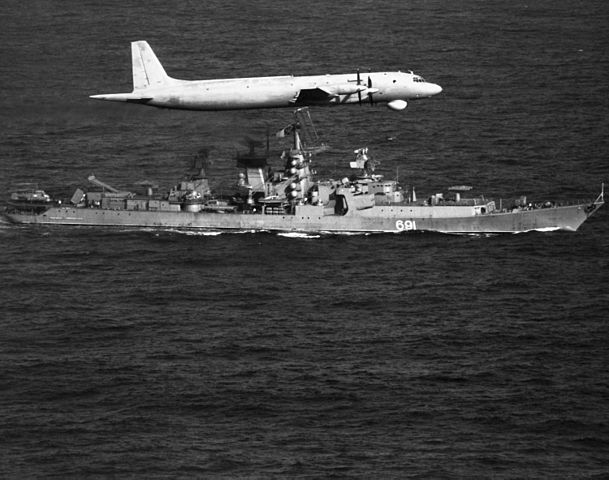
Marshal Timoshenko and Il-38 in 1985
Laid down on 2.11.72 and launched 21.10.73, Marshal Timoshenko was completed on 25.11.75. Until November that yeat 75 she trained in the Baltic and in 1976 sailed to Severomorsk to be attached to the 120th Missile Ship Brigade (Northern fleet). Untm Sept. 1976 she certified in weapons testings in the Barents Sea with Kiev also taking part in the exercise “Osen-76” with Admiral Isachenkov, and tracked USS John. F. Kennedy and HMS Ark Royal. In April 1977 she took part in “Sever-77”, a large command staff exercise followed by the air defence exercise “Estafeta-77”. At the fall of the year she was attached to the 170th Anti-Submarine Warfare Brigade and until April 1978 she trained in the Northeastern Atlantic, also searching for fragments of crashed Tu-16R at Svalbard Island in Norway. Based in Severomorsk until late 1979 she took part in another command staff ASW exercise, “Razbeg-79”. She departed in December for the Mediterranean and trained there unyil April 1980 with Kiev and Admiral Isachenkov.
June saw her in the “Atlantika-80” exercise, as flagship. Until late 1981 she trained in the Mediterranean with Kiev and Isachenkov, visiting Rieka but on 24.10.81 was stranded on the bottom in Kandalaksha Bay and damaged, repaired at SRZ Severodvinsk. In Feb. she took part in rescue operations for the K-123. Until December 1982 she was n the Southwestern Atlantic and visited Conakry (Guinea), Pointe Noire (Congo) and Sao Tome and Pricipe, Luanda and Mosamedish in Angola. In late 1983 she took part in “Magistral-83” and “Okean-83” with Aleksandr Nevskiy and Admiral Zozulya, Admiral Yumashev. Until June 1985 she trained in the Mediterranean and Red Sea and tracked USS Dwight D. Eisenhower. She passed the Suez Canal to the Red Sea and visited Aden and back in the Med, Dubrovnik. The same year she was in the command staff exercise with Kirov and Kiev and fired SS-N-14 and SAMs. In June 1987 she sailed to Kronshtadt and from 27 October 1988, underwent a major overhaul and modernization at KMOLZ by 95th Battalion, but work stopped in 1991 due to lack of funds and she was decomissioned and sold in 1994.
Vasiliy Chapayev
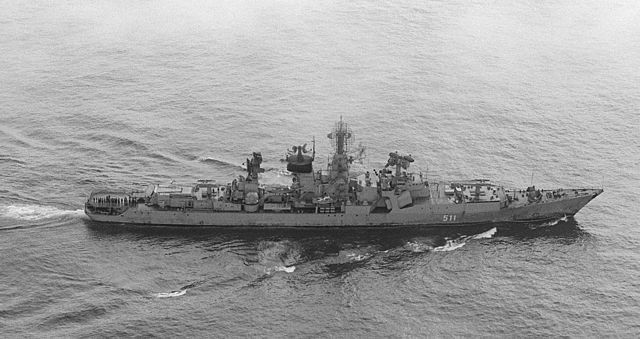
Vasiliy Chapaev in 1983
Vasiliy Chapaev was laid down 22.12.73 and launched in 28.11.74. After a completion on 30/11 1976 she was attached to the 12th Missile Ship Division and in 1978 sailed to Vladivostok, for Southwestern Atlantic operation with Admiral Oktyabrskiy. She visited Havana and Cienfuegos, and back on the Western African coast, Luanda, Maputo, passed the cape, stopped in and Aden, Bombay in late 1977. From late march 1978 she was attached to the 201st Anti-Submarine Warfare Brigade and took part in the ASW exercise “Piton” with Admiral Oktyabrskiy in the Philippine Sea, while alater operating in the South China Sea with Admiral Senyavin and Admiral Fokin, showing support for Vietnam during the Sino-Vietnamese border war. In 1982 she was in operations in the Indian Ocean visiting many ports including including Victoria (Seychelles) and Sokrota Island, Dakhlak and Maputo in Mozambique and Cam Ranh Bay in Vietnam or Aden and Indian cities.
In 1983 she in drydock in Dalzavod, Vladivostok for an overhaul and was back until May 1984 for operations in the Philippine and South China Seas. She visited Wonsan in NKA. She also took part in the ASW exercise “Dlinnaya Osen” in the Okhotsk sea with Novorossiysk and Nikolayev, and performed tactical exercise off Hawaii with the same and Tashkent, Tallin and other destroyers. In 1986 she was in operations in the South China Sea and Indian Ocean and took part in the first Soviet/North Korean exercise with Tashkent, Gordelivyy and five Tarantul class missile corvettes and other operations in the Indian Ocean in 1987. Nothing notably happened until 1990, where she was mothalled, then put in reserve in 1992, decommissioned 1993 and sold 1994.
Admiral Yumashev
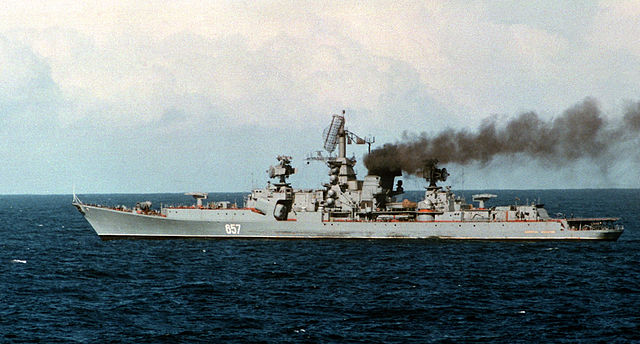
Admiral Yumashev
Laid down under the Serial no. 730 on 17.4.75 and launched on 30.9.76, Admiral Yumashev was completed 30.12.77 and made her sea trials and training in the Baltic. In 1978 she was visited by Commander of the Navy Gorshkov and later sailed to Severomorsk, joining the 170th Anti-Submarine Warfare Brigade. In 1978-79 she was in operations in the Mediterranean and the Central Atlantic with Kiev. She crossed the Suez Canal and sailed to the South China Sea to bring support to the Vietnamese furing the 1979 conflict. She was back in the Med with Minsk as well as escorted Kiev and taking part in exercises “Razbeg” and “Safari”. She shadowed also the NATO exercise “Ocean Hunt-79”. In 1980 she was in the Northern and Central Atlantic and in 1981-1982 in the Mediterranean. She was overhauled at SRZ-13 Sevastopol that year.
Back at sea, she tracked USS Dwight D. Eisenhower and this was featured in the Italian press when she refused to aid a sinking Italian fishing vessel. She also visited Bizerta in Tunisia. In March 1983 she took part in an AA defence exercise with Kirov and four DDs. She also took part in the “Magistral-83” and “Okean-83” command staff exercises with Aleksandr Nevskiy, Admiral Zozulya, Sovremennyy, Otchayannyy, Admiral Timoshenko and Stroynyy. She later tracked NATO exercise “Team Work.84” in the Norwegian Sea but suffered storm damage at this occasion and had to be repaired. Until the fall, she was operations in the Southern Atlantic, stopping at Luanda (Angola) and Conakry in Guinea, passed the equator and dropped anchor at Pointe Noire in Congo and Praya (Cape Verde) as well as Kotona in Benin, Sao Tome and Pricipe and returned to Luanda to escort Cuban transports there.
From June 1986 she underwent an overhault at SRZ-35 Rosta and in 1986 she tracking a NATO exercise in the Barents Sea and in the Norwegian Sea. After another storm damage she was repaied. In 1987 she took part in a command staff exercise with Kirov, Vitse-Admiral Drozd, Marshal Ustinov, Admiral Nakhimov, Admiral Makarov and four missile DDs. In 1987 she was drydocked for a major modernization in SRZ-35 Rosta stopped in 1989 for budgetary reasons. Left here she was attached to the 44th Anti-Submarine Warfare Division but decomissioned in 1992 and sold for BU in 1994.

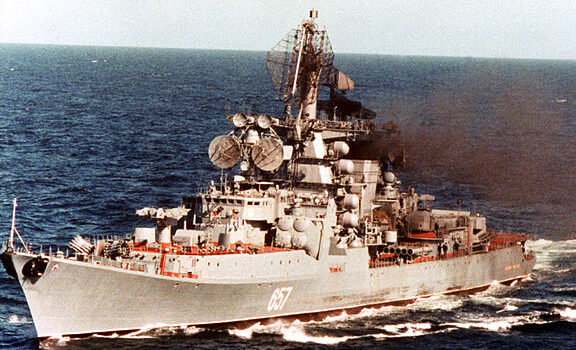
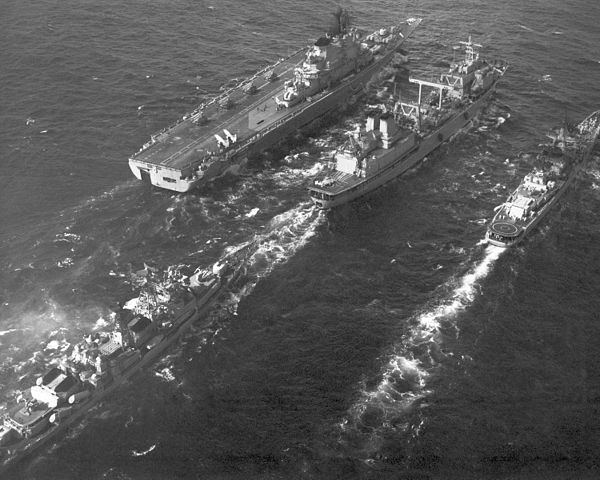
 Latest Facebook Entry -
Latest Facebook Entry -  X(Tweeter) Naval Encyclopedia's deck archive
X(Tweeter) Naval Encyclopedia's deck archive Instagram (@navalencyc)
Instagram (@navalencyc)





 French Navy
French Navy Royal Navy
Royal Navy Russian Navy
Russian Navy Armada Espanola
Armada Espanola Austrian Navy
Austrian Navy K.u.K. Kriegsmarine
K.u.K. Kriegsmarine Dansk Marine
Dansk Marine Nautiko Hellenon
Nautiko Hellenon Koninklije Marine 1870
Koninklije Marine 1870 Marinha do Brasil
Marinha do Brasil Osmanlı Donanması
Osmanlı Donanması Marina Do Peru
Marina Do Peru Marinha do Portugal
Marinha do Portugal Regia Marina 1870
Regia Marina 1870 Nihhon Kaigun 1870
Nihhon Kaigun 1870 Preußische Marine 1870
Preußische Marine 1870 Russkiy Flot 1870
Russkiy Flot 1870 Svenska marinen
Svenska marinen Søværnet
Søværnet Union Navy
Union Navy Confederate Navy
Confederate Navy Armada de Argentina
Armada de Argentina Imperial Chinese Navy
Imperial Chinese Navy Marinha do Portugal
Marinha do Portugal Mexico
Mexico Kaiserliche Marine
Kaiserliche Marine 1898 US Navy
1898 US Navy Sovietskiy Flot
Sovietskiy Flot Royal Canadian Navy
Royal Canadian Navy Royal Australian Navy
Royal Australian Navy RNZN Fleet
RNZN Fleet Chinese Navy 1937
Chinese Navy 1937 Kriegsmarine
Kriegsmarine Chilean Navy
Chilean Navy Danish Navy
Danish Navy Finnish Navy
Finnish Navy Hellenic Navy
Hellenic Navy Polish Navy
Polish Navy Romanian Navy
Romanian Navy Turkish Navy
Turkish Navy Royal Yugoslav Navy
Royal Yugoslav Navy Royal Thai Navy
Royal Thai Navy Minor Navies
Minor Navies Albania
Albania Austria
Austria Belgium
Belgium Columbia
Columbia Costa Rica
Costa Rica Cuba
Cuba Czechoslovakia
Czechoslovakia Dominican Republic
Dominican Republic Haiti
Haiti Hungary
Hungary Honduras
Honduras Estonia
Estonia Iceland
Iceland Eire
Eire Equador
Equador Iran
Iran Iraq
Iraq Latvia
Latvia Liberia
Liberia Lithuania
Lithuania Mandchukuo
Mandchukuo Morocco
Morocco Nicaragua
Nicaragua Persia
Persia San Salvador
San Salvador Sarawak
Sarawak Uruguay
Uruguay Venezuela
Venezuela Zanzibar
Zanzibar Warsaw Pact Navies
Warsaw Pact Navies Bulgaria
Bulgaria Hungary
Hungary

 Bundesmarine
Bundesmarine Dutch Navy
Dutch Navy Hellenic Navy
Hellenic Navy Marina Militare
Marina Militare Yugoslav Navy
Yugoslav Navy Chinese Navy
Chinese Navy Indian Navy
Indian Navy Indonesian Navy
Indonesian Navy JMSDF
JMSDF North Korean Navy
North Korean Navy Pakistani Navy
Pakistani Navy Philippines Navy
Philippines Navy ROKN
ROKN Rep. of Singapore Navy
Rep. of Singapore Navy Taiwanese Navy
Taiwanese Navy IDF Navy
IDF Navy Saudi Navy
Saudi Navy Royal New Zealand Navy
Royal New Zealand Navy Egyptian Navy
Egyptian Navy South African Navy
South African Navy






























 Ukrainian Navy
Ukrainian Navy dbodesign
dbodesign
Hi, please can you tell me which Kresta II had a pennant number of 667 in 1983, possibly serving with the Northern Fleet?
Many thanks
Hello Graeme, that’s a difficult one to answer, as i don’t have these informations yet, but the Kresta II article will be ported to standards in 2019 or 2020, it’s a 15 years old traduction and will be beefed-up considerably, with active service records for all ships and therefore their assignations. Check Facebook for the official release !